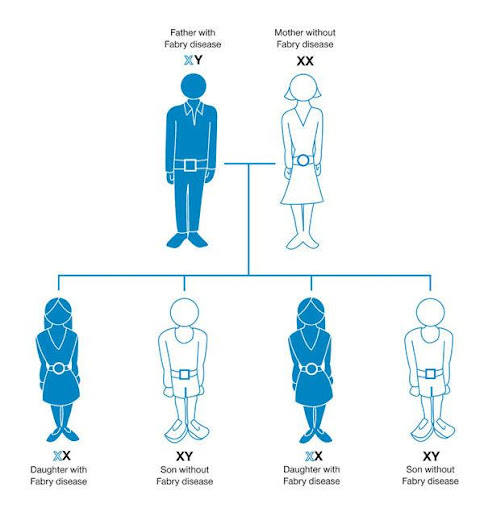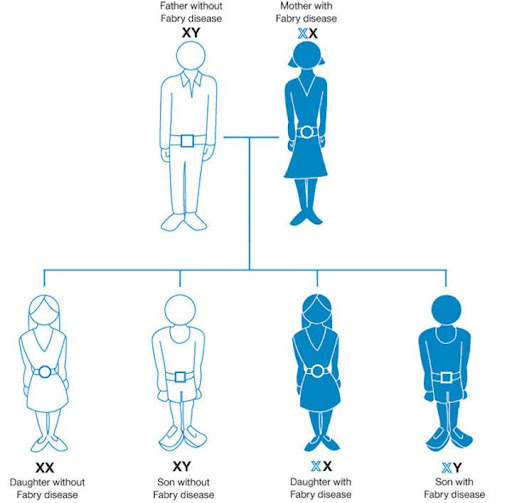Who Can Get Fabry?
How Fabry Disease Is Inherited?
All of our hereditary information is contained on genes. We have genes that determine our physical characteristics like our hair colour, eye colour, sex. We also have genes that are responsible for specific functions such as our metabolism and growth. Each cell in the human body contains 23 pairs of chromosomes. It is these chromosomes that hold our genetic ‘blueprint’. Each chromosome making up a pair is the same except for the chromosomes that determine a person’s sex. These chromosomes are called X and Y.
Men have one X chromosome and one Y chromosome (XY)
Women have two X chromosomes (XX)
A sperm and an egg contain one chromosome each. A sperm can contain an X or a Y chromosome but an egg contains only an X chromosome. When a sperm containing an X chromosome fertilizes an egg, the child will be a girl (XX). If the sperm contains a Y chromosome, the child will be a boy (XY).
It is the passing of this ‘blueprint’ in the chromosomes from parents to children that makes Fabry disease a genetic disorder. The gene alteration (often referred to as a ‘mutation’) that causes the enzyme alpha-galactosidase A (a-Gal A) to malfunction is found on the X chromosome.
Therefore, an affected male diagnosed with Fabry Disease (XY), will pass the altered gene to ALL of his daughters but not to his sons. Sons of affected males do not inherit the gene.
An affected female diagnosed with Fabry Disease (XX) will have a 50% chance of passing the altered gene to any child she has whether they are male or female.
Fabry disease once thought a typical ‘X linked recessive condition’ and in theory this is the case, but there are examples whereby a ‘spontaneous mutation’ has occurred meaning there has been no hereditary pattern within that particular family. There is significant research and data to show that women who were always classed as ‘carriers’ therefore not having the disease, can have symptoms as severe as affected males with classic Fabry disease. While other females
may be seemingly asymptomatic, only experience mild symptoms, or exhibit any variation of symptoms in between.
It is generally preferred to refer to a female with a disease-causing Fabry mutation but who doesn’t have symptoms as an asymptomatic female rather than a “carrier”. The term “carrier” is usually reserved for a female who is a carrier but CANNOT have symptoms such as in an X-linked recessive disease.
When a gene mutation spontaneously occurs in a family for the first time rather than by inheritance, it is called a de novo mutation.

In the situation where it is the mother who has Fabry disease, there is a 50% chance that each child born will also have Fabry disease. If boys inherit the altered X chromosome from their mother, they will develop symptoms, but if they inherit the normal X chromosome from their mother, they will not. If girls inherit the altered X chromosome then they may or may not show symptoms of Fabry disease.

Fabry Australia ‘Understanding Fabry Disease’ Factsheet
Understanding Fabry Disease booklet was produced by Fabry Australia and reviewed by Fabry Australia’s Medical Advisory Committee. It is an excellent resource for explaining Fabry disease to a new diagnosed patient and their family and or friends. It is a helpful resource to show health professionals unfamiliar with Fabry Disease.

